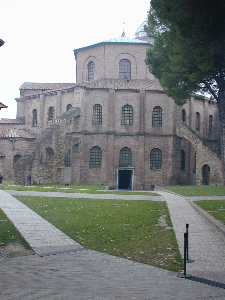
For our last full day, we took the train from Rimini to Ravenna with a view to seeing the byzantine mosaics. The centre of Ravenna is a short walk from the station. It is entirely free of cars, one of the locals said that there was no room for cars in the narrow streets. People have taken to cycling in a big way.
Ravenna was capital of the western region of the empire during the reign of Emperor Justinian and Empress Theodora. The result is that the town has many basilicas from that era. First we visited San Vitale, a big centralised basilica with an octagonal dome supported by marble columns built in AD 547. The marble on the massive square columns is cut in such a way as to display repeated patterns. Below the dome is a balcony supported on smaller columns.

In the chancel there is a big collection of mosaics using many more colours than the roman ones (e.g. blue, green and gold) - some of the pieces look glassy. The backgrounds are generally coloured rather than being white. The mosaic at the end of the chancel represents Emperor Justinian and his wife Theodora.
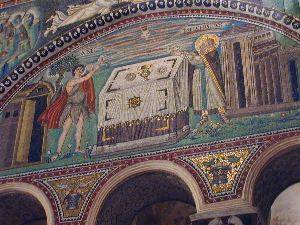 |
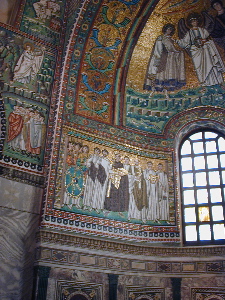 |
Next door to San Vitale is the mausoleum of Galla Placida which has alabaster widows and contains some older mosaics as well as a tomb.
The basilica of S. Apollonare Nuovo is of a simpler construction. It has a nave and two aisles with marble columns supporting the roof of the nave. The end is semicircular and is lined with mosaics, with martyrs on one side and virgins on the other. The mosaics include pictures of palaces.
We visited a couple of other basilicas and also the tomb of Dante, who lived in Ravenna after having been exiled from Florence.
The basilica of S. Apollonare in Classe is outside the town. It is conveniently close to the first stop on the train back to Rimini.At that time the port of Ravenna was at Classe. The basilica is of a very similar construction to S. Apollonare Nuovo. The marble columns appear to be made from one piece. There are very fine paintings of people in a frieze above. At the far end there are steps up to an altar and mosiacs at the end., Christ surrounded by sheep, green hills and rocks. Above that mosaic are horses and palaces. At the sides, pictures of people.
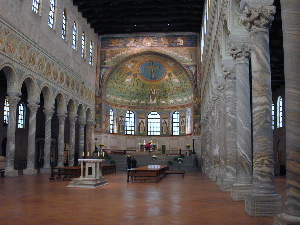 |
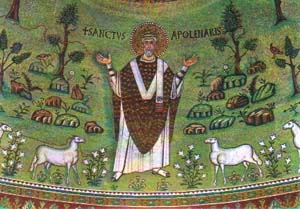 |
| Go to index page | See more photos of Ravenna |